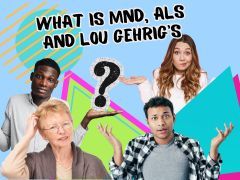Terminology and acronyms in the health and disability sectors can be confusing. An example of this is the difference between motor neurone disease (MND), amyotrophic lateral sclerosis (ALS) and Lou Gehrig’s Disease. In Australia we generally use the term motor neurone disease or MND, so what’s the difference between MND, ALS and Lou Gehrig’s Disease?
Spoiler alert – they are essentially the same thing!
MND is an umbrella term that describes a group of progressive neurological conditions where the motor neurones degenerate and die. Amyotrophic lateral sclerosis or ALS is the most common type of MND and ALS is often called Lou Gehrig’s Disease. Confused yet?
Read on to find out more about the different terms and where to get information and support.
What is Motor Neurone Disease (MND)?
Motor neurone disease (MND) is the umbrella term given to a group of diseases that affect the motor neurones in the body. Neurones control muscles and glands that enable people to move, speak, breathe and swallow. When someone has MND these neurones degenerate and die.
There are four main types of MND. These types are defined by the site of symptom onset, how the disease affects parts of the body and how it progresses. They all involve the degeneration of motor neurones which is why they are included under the umbrella term, MND. There are other types of MND that are less common, including MND with frontotemporal dementia (MND FTD).
The four main types of MND are:
- Amyotrophic lateral sclerosis (ALS)
- Progressive bulbar palsy (PBP)
- Progressive muscular atrophy (PMA)
- Primary lateral sclerosis (PLS).
Find out more about the types of MND.
What is Amyotrophic Lateral Sclerosis (ALS)?
ALS is the most common type of MND and is estimated to account for up to 70% of cases. ALS involves both upper and lower motor neurone involvement and typically starts in the arms, legs or throat. ALS is life limiting with a life expectancy of 2 to 5 years. In some countries MND is referred to as ALS as it is the most common type.[1]
What is Lou Gehrig’s Disease?
The term Lou Gehrig’s Disease came from the United States of America in the late 1930’s. Lou Gehrig was a famous baseballer who was diagnosed with ALS, the most common type of MND.[2]
Gehrig’s diagnosis came in the prime of his career. The progressive weakness he experienced was widely observed on television and reported in the press. The media documented the gradual progression of his symptoms and the loss of the power hitting swing that defined his career.[3] By the start of the 1939 baseball season his symptoms became so severe that his coordination, strength and speed were affected. He was diagnosed with ALS midway through 1939, leading him to retire from baseball.[4]
Lou Gehrig was a common household name at the time and somewhat of a national icon. His diagnosis brought such significant community awareness about the disease that subsequently ALS was called Lou Gehrig’s Disease.
ALS is still frequently called Lou Gehrig’s Disease in America and across parts of the world.
Support and Resources Available
MND NSW provide several different supports to people diagnosed with MND and their families:
Summary
- MND is an umbrella term for a group of neurological diseases where the motor neurones degenerate and die.
- There are four main types of MND.
- ALS is the most common type of MND.
- MND is often called ALS or Lou Gehrig’s Disease.
- There is support available – 1800 777 175.
Further information about MND
[1] MND Connect: Types of MND: ALS, PLS, PBP, PMA, MND/FTD | MND Australia
[2] ALS Association: Lou Gehrig and the History of ALS | The ALS Association
[3] Ibid
[4] University of Pittsburgh: Brain Institute - About Lou Gehrig | Brain Institute | University of Pittsburgh




